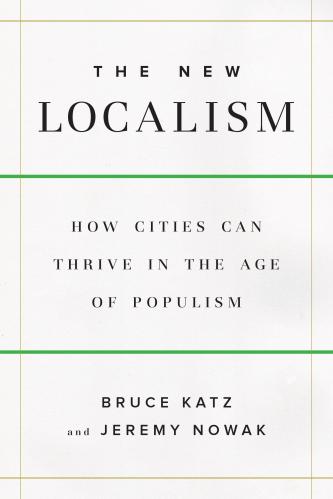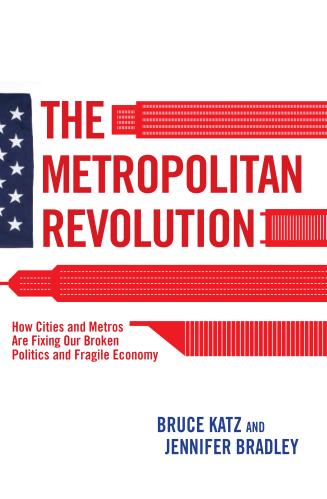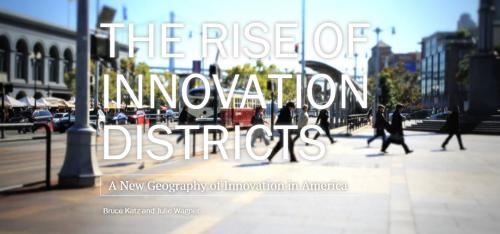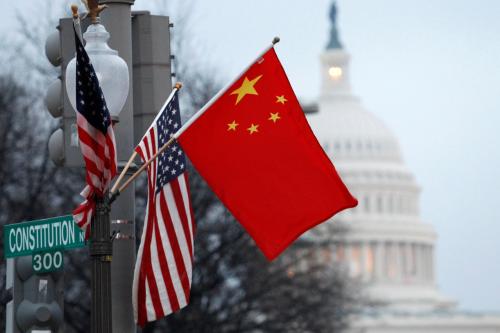This article originally appeared in CityLab on June 11, 2017.
There it was: the gentrification question, in at number five.
It gets asked at nearly every event at which I speak about innovation districts. Sometimes it feels like an accusation, underpinned by a somewhat paradoxical assumption that innovative economic growth in cities will inevitably have a destructive impact on poor residents.
This particular event was the release of Brookings’ new report “Connect to Compete: How the University City-Center City innovation district can help Philadelphia excel globally and serve locally.” In addressing the complex issue of economic inclusion, it flips the script by focusing not on who might get squeezed out by the innovation economy, but rather on how greater numbers of people can connect in. The culmination of 18 months of on-the-ground research, the report details the challenges and opportunities in Philadelphia’s University City and western Center City—areas that for years have been growing toward one another to create a hub of economic activity. It also offers recommendations for how the area’s anchor institutions and companies can better leverage their research and technology strengths to drive firm and job growth.
The geographic focus was intentional. The area is stacked with university, medical, and corporate assets—including Penn, Children’s Hospital of Philadelphia (CHOP), Drexel, and Comcast, to name a few. If you’ve spent any time in this part of Philly over the past several years, you’ve watched it grow into an entrepreneurial hotspot brimming with young professionals, researchers, and startup leaders who want to be where the action is. Dense with restaurants, retail, and transit, the area radiates energy, and Philadelphians are starting to feel its effects.
But in this innovation hub, as in many others around the country, there lurks a tension between the desire for economic growth and the suspicion that the rewards may only go to a well-heeled few. Indeed, it is the same tension that is pulling at the nation, creating what feels like a bottomless rift over what’s causing our economic disparities—including the role of technology and innovation—and what ought to be done to bridge the divides. This tension drives the gentrification question, every time.
Yet in Philadelphia, as in most cities, it is not gentrification that is widening the gap between the people and communities who are succeeding in this economy and those who are not: It’s the rise in concentrated poverty.
Poverty rates in the zip codes that include and surround the innovation district have been going up, not down.
At 26 percent, Philadelphia has one of the highest big-city poverty rates in country, with its poorest citizens largely clustered in the poorest neighborhoods. This dynamic has only gotten worse over time. Research by the Pew Charitable Trust reveals that from 2000 to 2014, 164 of the city’s 372 residential Census tracts experienced statistically significant drops in median household income. By contrast, only 15 tracts gentrified—shifted from having a predominantly low-income population to a high-income one.
National analysis by City Observatory reveals that such trends are the norm, not the exception. Residents of these communities are underemployed and underserved, and largely detached from the growth and revitalization occurring in other parts of their cities.
For the residents of cities like Philadelphia, such growth and revitalization is a long time coming.
As suburbanization continues apace, shifting demographic and market forces are putting wind at cities’ backs. This is particularly true in the urban innovation economy, where firms’ demand for proximity is coupling with workers’ desire for walkability and authenticity to create dense zones of economic vitality. These complementary forces are bringing more revenues to public accounts that can be reinvested in education, workforce development, infrastructure, neighborhood renewal, and other city priorities.
Philadelphia’s University City-Center City innovation district is one of those areas. Between 2004 and 2014, the number of jobs in this geography rose by 20 percent, and since then a substantial amount of new development suggests those numbers have likely increased. Most of these jobs (57 percent) do not require a college degree, and many are in decent-paying occupations like bookkeeping, respiratory therapy, and security.
This growth is occurring within blocks of some of Philadelphia’s most distressed communities. Poverty rates in the three West Philadelphia zip codes that include and surround the innovation district average nearly 40 percent, and median incomes are below $20,000. Moreover, poverty rates have been going up, not down, in these neighborhoods—a signal that, while development in the innovation district might not yet be driving gentrification, it is not yielding many spillover benefits either.
That can change.
In Philadelphia as in all cities, the rise of urban innovation hubs and the jobs that come with them presents a crucial chance to engage residents who have been largely excluded from economic growth. But it won’t happen by accident: Changing the opportunity dynamic for low-income communities and populations requires intentional efforts, scaled for impact.
This is what we recommend in our report. We lead with strategies to improve the innovation economy, calling for initiatives aimed at growing the city’s advanced industry clusters, starting with precision medicine, and placemaking, transit, and other infrastructure enhancements to strengthen the physical connections among innovation district institutions, firms, innovation spaces, and amenities. We then suggest that the stakeholders in the area align and scale existing skill-building, education, and procurement programs to build a stronger, more diverse talent pipeline and expand business development opportunities for local firms.
For example, the West Philadelphia Skills Initiative takes a place- and employer-based approach to workforce training, working directly with Drexel, CHOP, Penn, and other employers in University City to develop tailored curricula for high-turnover occupations that neighborhood residents can fill. Over 600 adults have participated in the program since its launch five years ago; job placement rates are around 90 percent.
Connecting local residents to nearby employers is critical: It eases commuting barriers, forges connections between the innovation district and surrounding communities, and raises area incomes. But it’s not a comprehensive solution to deep-seated neighborhood poverty: It needs to be coupled with initiatives aimed at growing local businesses (particularly minority-owned firms), improving neighborhood schools, and working with residents to create quality places in which a diversity of people feel a sense of pride and attachment.
Gentrification has many connotations, but all of them assume some degree of change—change in who lives in a community, which businesses and jobs can be found there, and how much land and buildings cost. Change can be worrying; embedded in those accusations I hear is also genuine concern. But given the current dynamics of poverty and disengagement in Philadelphia and throughout the country, it is hard to imagine how we build a more inclusive, equitable economy without it.
The Brookings Institution is committed to quality, independence, and impact.
We are supported by a diverse array of funders. In line with our values and policies, each Brookings publication represents the sole views of its author(s).



![An aerial view of the Philadelphia innovation district [photo credit: SHoP Architects/West 8]](https://www.brookings.edu/wp-content/uploads/2017/05/philadelphia_idreport_webbanner001.jpg?quality=75&w=500)






Commentary
Does innovation equal gentrification?
July 11, 2017